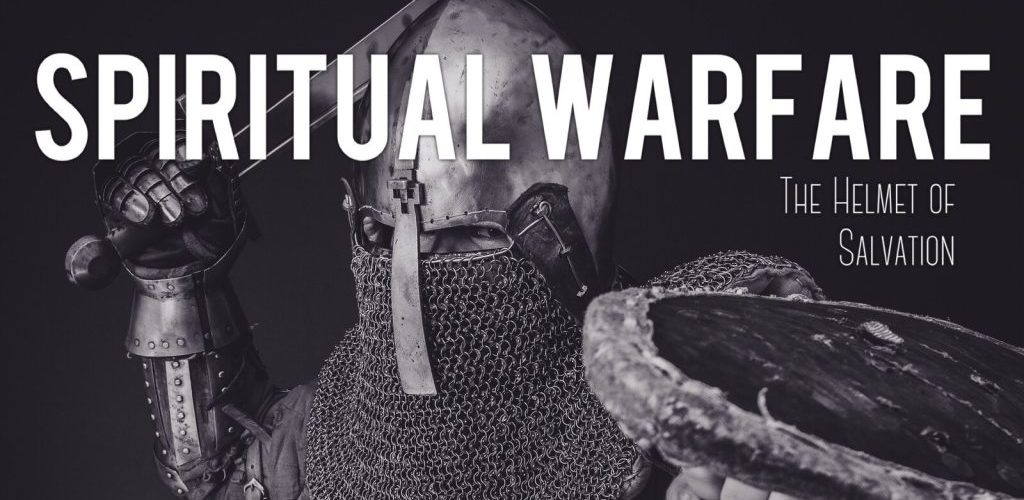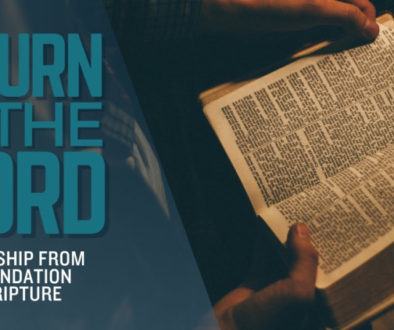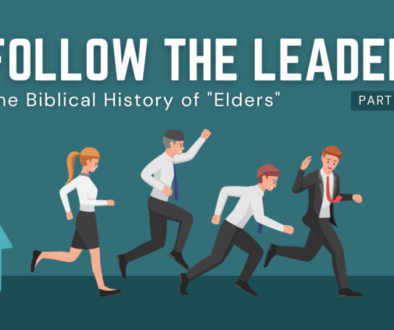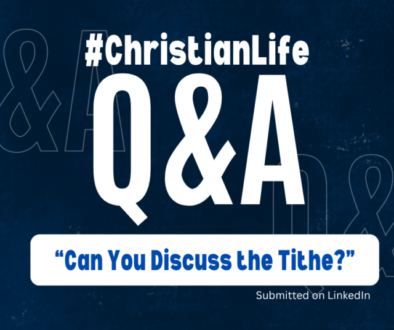Therefore take up the whole armor of God, that you may be able to withstand in the evil day, and having done all, to stand firm. Stand therefore, having fastened on the belt of truth, and having put on the breastplate of righteousness, and, as shoes for your feet, having put on the readiness given by the gospel of peace. In all circumstances take up the shield of faith, with which you can extinguish all the flaming darts of the evil one; and take the helmet of salvation, and the sword of the Spirit, which is the word of God, praying at all times in the Spirit, with all prayer and supplication. Ephesians 6:13-18a
In this series on Spiritual Warfare and the Armor of God, we began by looking at the foundational pieces of our armor, which give us the ability to “stand firm.” These included the Belt of Truth, the Breastplate of Righteousness, and the Shoes of the Gospel of Peace. Then, with the Shield of Faith, we turned our attention to those pieces of armor which Paul commanded us “in all circumstances” to “take up,” implying their use is for active battle with the enemy. This active usage is necessary to understand as we turn our attention to the “Helmet of Salvation.”
Protection for Your Head
First and foremost we must see that a helmet covers our head in battle, yet it is not something a person would wear full-time. Soldiers at rest would still be wearing their breastplates, belts, and shoes. However, when not in battle, they would remove their helmets, and set down their shields and swords. Now, even though Paul implies that our battle is 24/7, and we must always be armed with these pieces of armor, this is an important distinction that Paul makes, in the purposes of the armor.
What we see, then, is that the helmet of salvation cannot be intended to imply simply being born-again. Born-again salvation is not something we can ever take off, or hope to survive without it. It is not something you “take up” and put down again. That salvation must cover your whole life, and is foundational to being able to put on any of God’s armor at all. So then what is Paul talking about?
When God Puts On His Armor
What Paul is doing in commanding us to “take up” the helmet of salvation, is actually pulling up a historical reference in Isaiah, in which God, as rescuer of His people, puts on His own armor and goes into battle.
The LORD saw it, and it displeased him that there was no justice. He saw that there was no man, and wondered that there was no one to intercede; then his own arm brought him salvation, and his righteousness upheld him. He put on righteousness as a breastplate, and a helmet of salvation on his head; he put on garments of vengeance for clothing, and wrapped himself in zeal as a cloak. According to their deeds, so will he repay…And a Redeemer will come to Zion, to those in Jacob who turn from transgression,” declares the LORD.
Isaiah 59:15-18,20
When God saw that there was no justice and there was no righteous one to deliver His people, He Himself went into battle. He put on the Breastplate of Righteousness, which we have already discussed. That is righteousness which guards the hearts from any sinful infiltration. Then He puts on His helmet of salvation – an active piece of battle armor – signifying that He has set His mind to bring salvation to others.
Bringing Salvation Into Battle
The point is that when we take up the helmet of salvation, our minds are completely covered (filled) by the mission of God to bring salvation into the world.
Of course, this does bring with it an element of personal salvation in the battle itself. We obviously set our mind on God who is our own deliverer, and know that He will see us through to the end. As one writer said,
The emphasis on salvation is not so much about final salvation as it is about the present experience of salvation, helping the readers to understand the divine power and deliverance they have already received in Christ.
Grant R. Osborne, Ephesians: Verse by Verse, Osborne New Testament Commentaries (Bellingham, WA: Lexham Press, 2017), 232.
More than our own salvation, though, this is about having the mindset of Jesus Himself, who came to “seek and save that which was lost” and to “destroy the works of the devil” (Luke 19:10 and 1 John 3:8)! As we put on the helmet of salvation, we are aligning ourselves with God in His battle, to bring salvation to the world. As Thomas Neufeld says,
the salvation of the believers is already assured (Ephesians 2:8). That is, after all, the gist of the whole first half of the letter. In the context of putting on the armor, however, the image of grasping the helmet of salvation is meant to place on the church the task of bringing liberation to those in bondage by imitating the God of Isaiah 59.
Thomas R. Yoder Neufeld, Ephesians, Believers Church Bible Commentary (Scottdale, PA: Herald Press, 2001), 303.
I want to go off topic for a minute, so that we can get a better picture of the value of the helmet of salvation (and the sword of the spirit).
The Mark of the Beast
There is a lot of discussion nowadays about the “mark of the beast” in Revelation 13, which will be taken by those who are unfaithful to God. While I know that there are many sci-fi thrillers that promote this as a microchip to be planted in the hands or foreheads of unbelievers and force upon Christians, I do not believe that is what John is discussing at all.
“Hands and forehead” is an example of metaphorical language, which was used repeatedly in scripture. Deuteronomy 6:8 commanded the children of Israel to bind God’s commands to their hands and their foreheads. In Exodus 13:8-10, Moses instructs the people that the celebration of Passover should take place every year, like a sign on their hands and their foreheads.
The symbolism of the hands and foreheads is fairly easy to understand. When you have something “on your head” it refers to the thoughts and intentions of your mind. Then, putting that same mark on your hands, implies the putting those thoughts into action. This is exactly why, when we see someone doing something dumb, we ask, “What has gotten in your head?” Or, when we see a child walking through the room, hiding something behind their backs, and we know they are planning to do something that is not ok, we asked them, “what is in your hand?”
The first rule of Bible Study is that “scripture interprets scripture.” Therefore, we must view the mark in Revelation 13 with the same understanding.
Humanism is on the Rise
In discussing the mark of the beast, the Bible says in Revelation 13:18,
This calls for wisdom: let the one who has understanding calculate the number of the beast, for it is the number of a man, and his number is 666.
First, we must understand that the number, 666, is prophetic language. The number of man is the number 6, as we were created on the 6th day. BibleStudy.org says,
In the Bible, the number 6 symbolizes man and human weakness, the evils of Satan and the manifestation of sin. Man was created on the sixth day.
https://www.biblestudy.org/bibleref/meaning-of-numbers-in-bible/6.html
Secondly, we must know that when something in scripture is repeated three times, it is a rhetorical device which implies the perfection of that thing. For example, in Isaiah 6:3 the seraphim declare that God is “holy, holy, holy.” He is not just holy. He is not just “more holy.” He is the “most holy” or “perfect in holiness.”
To apply the same device to the number of man — the triple 6 — the mark of the beast is not just the number of sinful man, but sinful man in his complete fallen state. It is the complete worship of ourselves as God, which was the original temptation (Genesis 3:5). It is the same attitude that led to the tower of Babel – to show mankind’s greatness (Genesis 11:4). It is the same “mark” that has driven modern-day “anti-Christs” like Hitler — to create the master race of mankind.
The number 666 implies a complete dedication to secular humanism – that we do not need a god, we can be God ourselves. To take that “mark” on our forehead, implies that all of our thoughts are guided by it, and to put it on our hands is to dedicate our works to building our own greatness in the world. It is to live our lives according to the lie, “you can be like God.”
The Mark of Christ
In opposition to the mark of the beast, we are called to have the mind of Christ, as Philippians tells us:
Have this mind among yourselves, which is yours in Christ Jesus, who, though he was in the form of God, did not count equality with God a thing to be grasped, but emptied himself, by taking the form of a servant, being born in the likeness of men. And being found in human form, he humbled himself by becoming obedient to the point of death, even death on a cross.
Philippians 2:5-8
When you have the mind of Christ, it is impossible to take the mark of the beast!
If it isn’t obvious, already, this is exactly the point of taking on the helmet of salvation. We cover our heads – our thoughts – with the purposes of God in this world. We stop thinking about building our own Kingdom. Instead, we are fully concerned with building His!
A One-Track Mind
This takes us back, then, to our first post in this series, where we discussed the role of mindsets in the Christian life and spiritual warfare. When our minds are fully consumed by the purposes and promises of God, the enemy has no chance at getting into our heads. He cannot break through that helmet with fear or anxiety, or selfish desires.
As we “take up” the helmet of salvation, we are dedicating our minds to the things of God, and refusing to let anything distract us from standing alongside Him in His battle for the salvation of the world. His desire is that “all would come to repentance” (2 Peter 3:9) and to bring about the restoration of all things. Our desire should be to stand with Him in battle with a mind to give Him the reward of His suffering.
We will discuss how those thoughts turn to action in the next post, where we will discuss the “sword of the Spirit.”
Let’s Connect
As always, I would love to hear your thoughts, questions, and testimonies in the comment section.
If you are encouraged by what you are reading, you can sign up for my weekly roundup newsletter, below. It would be a privilege to have you, and I promise never to spam you or share your information with anyone!
You can also join me on Facebook, Instagram, Twitter, and Parler, to continue the discussion on this post and more!
Photo by Henry Hustava on Unsplash
Unless otherwise indicated, all Scripture quotations are from The Holy Bible, English Standard Version®, copyright © 2001 by Crossway Bibles, a publishing ministry of Good News Publishers. Used by permission. All rights reserved.”



